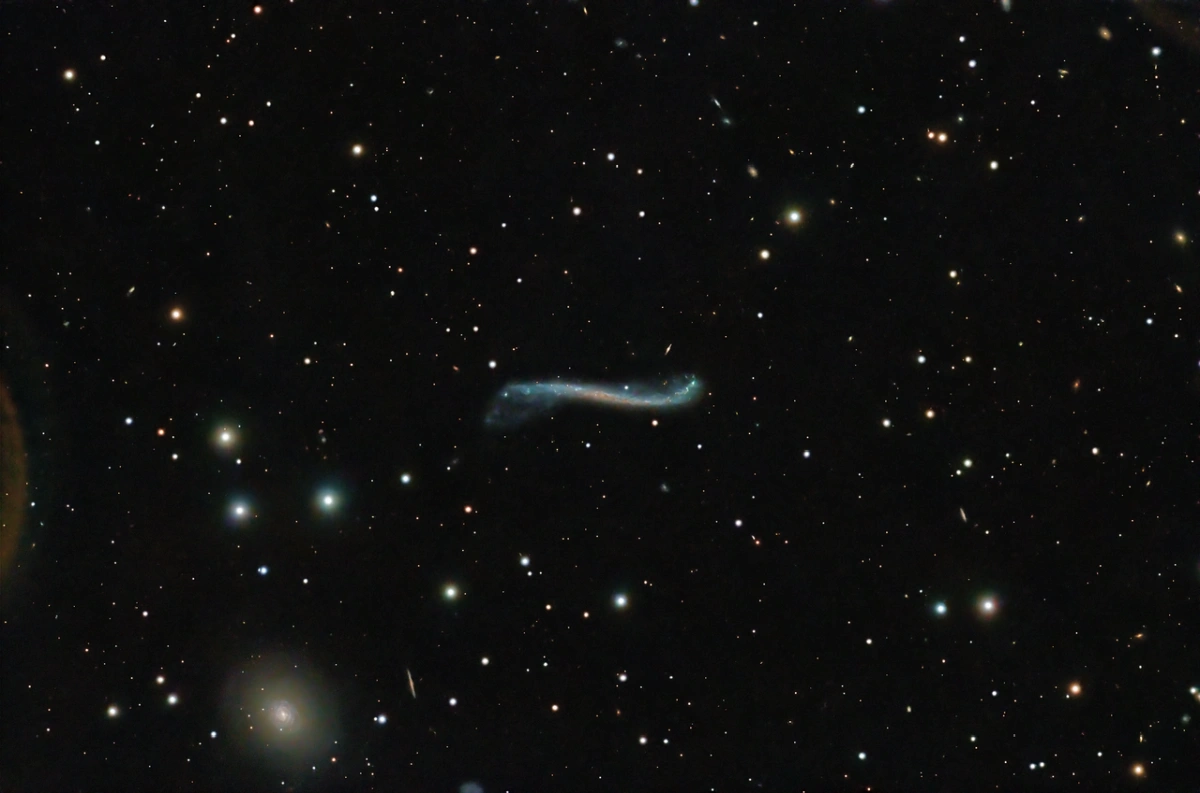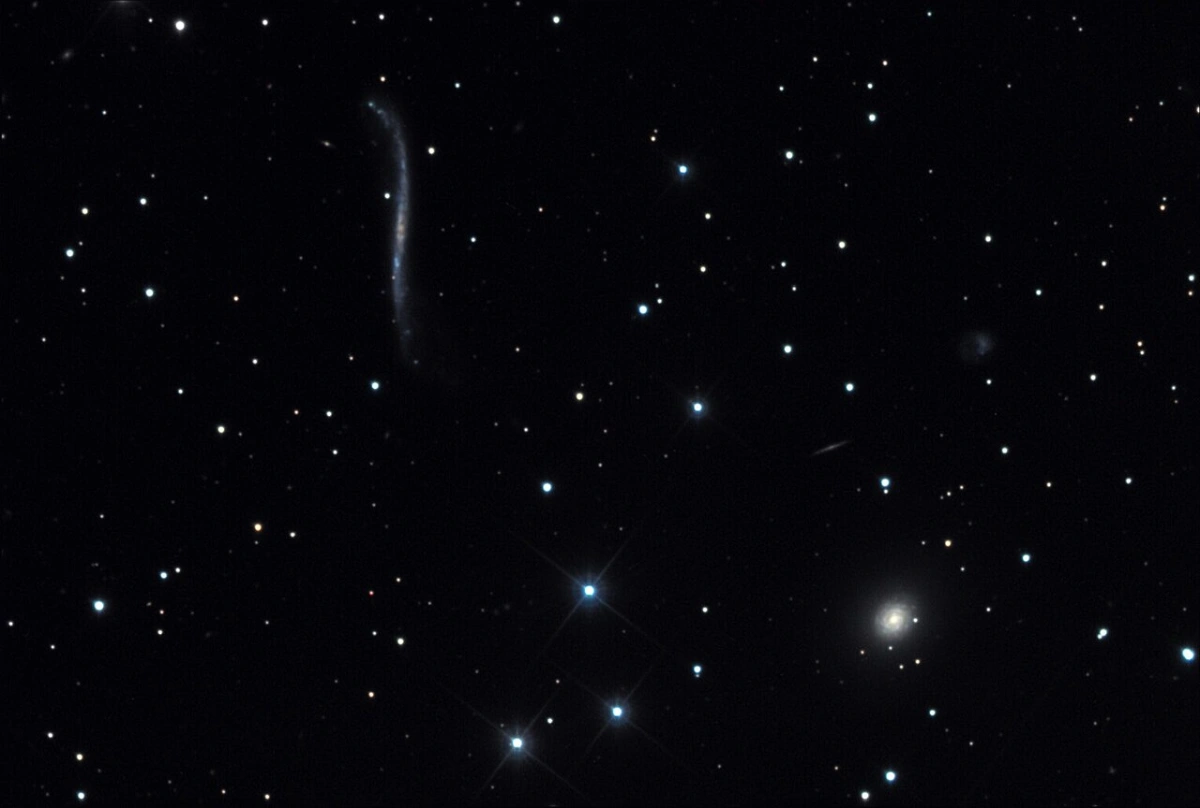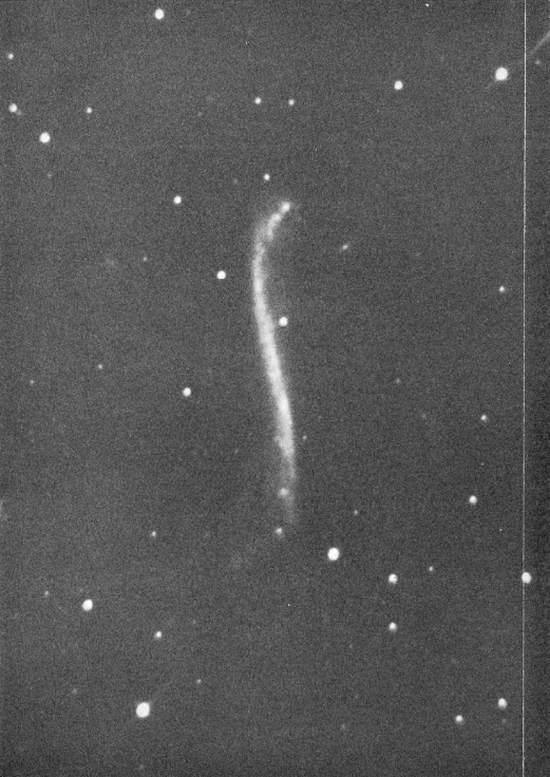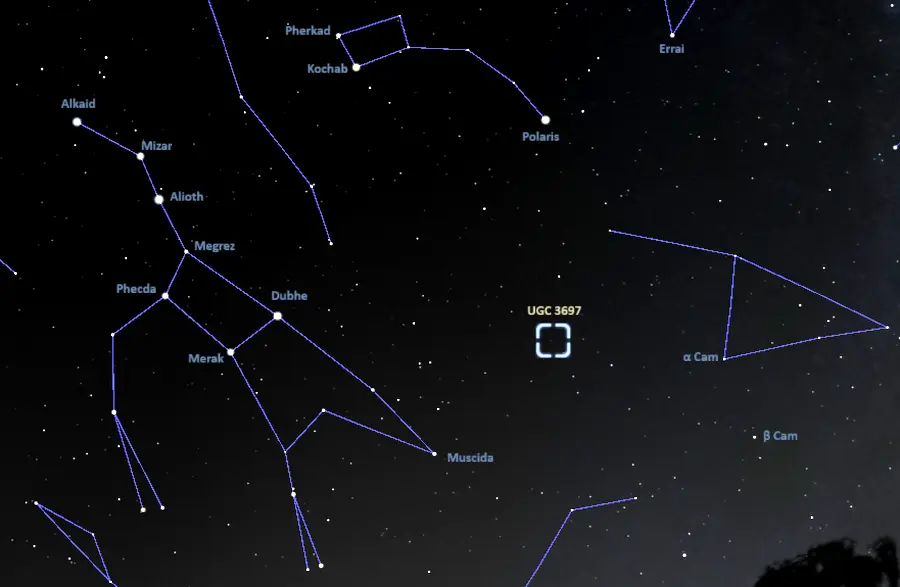The Integral Sign Galaxy is an edge-on spiral galaxy located in the northern constellation Camelopardalis (the Giraffe). The low-mass galaxy lies approximately 150.84 million light years away. It is catalogued as UGC 3697 in the Uppsala General Catalogue of Galaxies.
The unusually thin, warped galaxy appears edge-on from our perspective. While other super-thin spiral galaxies typically have a flat disk, the disk of the Integral Sign Galaxy curls at the edges and appears wavy. The galaxy’s warped shape is believed to be the result of tidal effects from the nearby dwarf galaxy UGC 3714, which lies around 39 kpc (127,200 light years) from UGC 3697. The shape of the disk may have also been affected by an infalling smaller galaxy.
A 2004 study by Lynn D. Matthews, Harvard-Smithsonian Center for Astrophysics, and Juan M. Uson, National Radio Astronomy Observatory (NRAO), reported strong evidence for a minor merger in the relatively recent past. The astronomers proposed that a mass of neutral hydrogen gas (H I) of a few times 108 solar masses has recently been accreted onto the thin edge-on galaxy. The merger could explain the super thin disk morphology of UGC 3697. A faint dwarf galaxy that appears near the southeastern tip of UGC 3697 may be the remnant of the infalling galaxy.

Integral Sign Galaxy (UGC 3697), image credit: Juan Lacruz (CC BY 4.0)
The astronomers suggested that the Integral Sign Galaxy is in a transient dynamical state and will soon experience significant changes in structure and morphology. Imaging with the Very Large Array (VLA) has revealed additional extensions to the galaxy’s warped disk. Astronomers found a bright concentration of neutral hydrogen emission near the galaxy’s western edge, and gas filaments extending up to 7 kiloparsecs from the bright blob.
Facts
The Integral Sign Galaxy is part of a small galaxy group that includes the peculiar galaxy UGC 3714 and several other dwarf galaxies. UGC 3714 is visually the brightest member of the group. Other members include the galaxies UGC 3804, LEDA 20460, UGC 3626, UGC 3644, UGC 3878, UGC 3838, UGC 3705, and UGC 3701.
The Integral Sign Galaxy was discovered by the English theoretical astrophysicist Geoffrey Burbridge in 1967. Burbridge found the galaxy on photographic plates obtained with the 82-inch McDonald telescope during the Palomar Observatory Sky Survey in February 1962.
The English astronomer gave a distance estimate of 44 megaparsecs (143.44 million light-years) and a diameter of 45 kiloparsecs (146,770 light years) for the galaxy, with an angular size of 140 arcseconds. The discovery was announced in The Astrophysical Journal, Vol. 150, in December 1967.

Integral Sign Galaxy. This image was taken as part of Advanced Observing Program (AOP) program at Kitt Peak Visitor Center during 2014. Credit:
KPNO/NOIRLab/NSF/AURA/Bonnie Fisher and Mike Shade/Adam Block (CC BY 4.0)
Burbridge noted, “The object has the very large over-all dimension of 45 kpc, has no nuclear concentration of stars, and contains much ionized gas. It is not in interaction with any other galaxy.” The astronomer referred to the object as GB 1 and nicknamed it the Integral Sign Galaxy because of the pronounced S-shaped bending of the galactic disk.
At the time of discovery, UGC 3697 was the only known galaxy with the shape of the integral sign. Even now, very few galaxies are known to have such an unusually pronounced warp.

Integral Sign Galaxy, image credit: Burbridge et al. (PD)
Location
The Integral Sign Galaxy lies in the faint constellation Camelopardalis. It is a challenging object to find because there are no bright stars or asterisms in the vicinity. The galaxy appears about two thirds of the way from Dubhe (Alpha Ursae Majoris) in Ursa Major to Alpha Camelopardalis in Camelopardalis.
UGC 3697 has a low surface brightness and is a challenging target even for larger amateur telescopes. 12-inch telescopes may reveal an elongated patch of light in exceptionally good conditions. 16-inch instruments will show the nearby dwarf galaxy UGC 3714, and the integral sign is visible in much larger telescopes.
At declination +72°, the Integral Sign Galaxy is best seen from the northern hemisphere. It never rises above the horizon for observers south of the latitude 18° S.

Location of the Integral Sign Galaxy (UGC 3697), image: Stellarium
Integral Sign Galaxy – UGC 3697
| Constellation | Camelopardalis |
| Object type | Spiral galaxy |
| Morphological type | Scd |
| Right ascension | 07h 11m 22.540s |
| Declination | +71° 50′ 10.94″ |
| Apparent magnitude | 13.5 |
| Apparent size | 3.21349′ x 0.408756′ |
| Distance | 150.84 million light-years (46.27 megaparsecs) |
| Redshift | 0.010487 ± 0.000053 |
| Heliocentric radial velocity | 3127 ± 16 km/s |
| Names and designations | Integral Sign Galaxy, UGC 3697, LEDA 20348, PGC 20348, MCG+12-07-028, GB 1, Anon 0705+71, FGC 601, LJHY 80, KUG 0705+719, IRAS 07055+7155, IRAS 0705+719P05, IRAS F07055+7155, 2MASX J07112254+7150109, HIJASS J0711+71, 2MFGC 5697, RFGC 1172, PSCz Q07055+7155, UZC J071119.5+715008, Z 330-26, Z 0705.6+7155, [CHM2007] LDC 492 J071122.54+7150109, [CHM2007] HDC 429 J071122.54+7150109, [M98c] 070532.5+715500 |